Laser welding of overlapping metal workpieces assisted by varying laser beam parameters
a technology of laser beam and overlapping metal workpiece, which is applied in the field of laser welding to achieve the effects of reducing solubility, improving strength and properties, and positive impacting the strength and other mechanical properties of laser weld joints
- Summary
- Abstract
- Description
- Claims
- Application Information
AI Technical Summary
Benefits of technology
Problems solved by technology
Method used
Image
Examples
Embodiment Construction
[0031]The disclosed method of laser welding a workpiece stack-up comprised of two or more overlapping metal workpieces involves forming a laser weld joint by repeatedly varying at least one of the power level of the laser beam, the travel speed of the laser beam, or the focal position of the laser beam while advancing a beam spot of a laser beam relative to a top surface of the workpiece stack-up along a beam travel pattern. Any type of laser welding apparatus, including remote and conventional laser welding apparatuses, may be employed to form the laser weld joint while repeatedly varying the designated beam parameter(s). The laser beam may be a solid-state laser beam or a gas laser beam depending on the characteristics and compositions of the metal workpieces being joined and the laser welding apparatus being used. Some notable solid-state lasers that may be used are a fiber laser, a disk laser, a direct diode laser, and a Nd:YAG laser, and a notable gas laser that may be used is ...
PUM
| Property | Measurement | Unit |
|---|---|---|
| travel speed | aaaaa | aaaaa |
| travel speed | aaaaa | aaaaa |
| travel speed | aaaaa | aaaaa |
Abstract
Description
Claims
Application Information
 Login to View More
Login to View More - R&D
- Intellectual Property
- Life Sciences
- Materials
- Tech Scout
- Unparalleled Data Quality
- Higher Quality Content
- 60% Fewer Hallucinations
Browse by: Latest US Patents, China's latest patents, Technical Efficacy Thesaurus, Application Domain, Technology Topic, Popular Technical Reports.
© 2025 PatSnap. All rights reserved.Legal|Privacy policy|Modern Slavery Act Transparency Statement|Sitemap|About US| Contact US: help@patsnap.com



